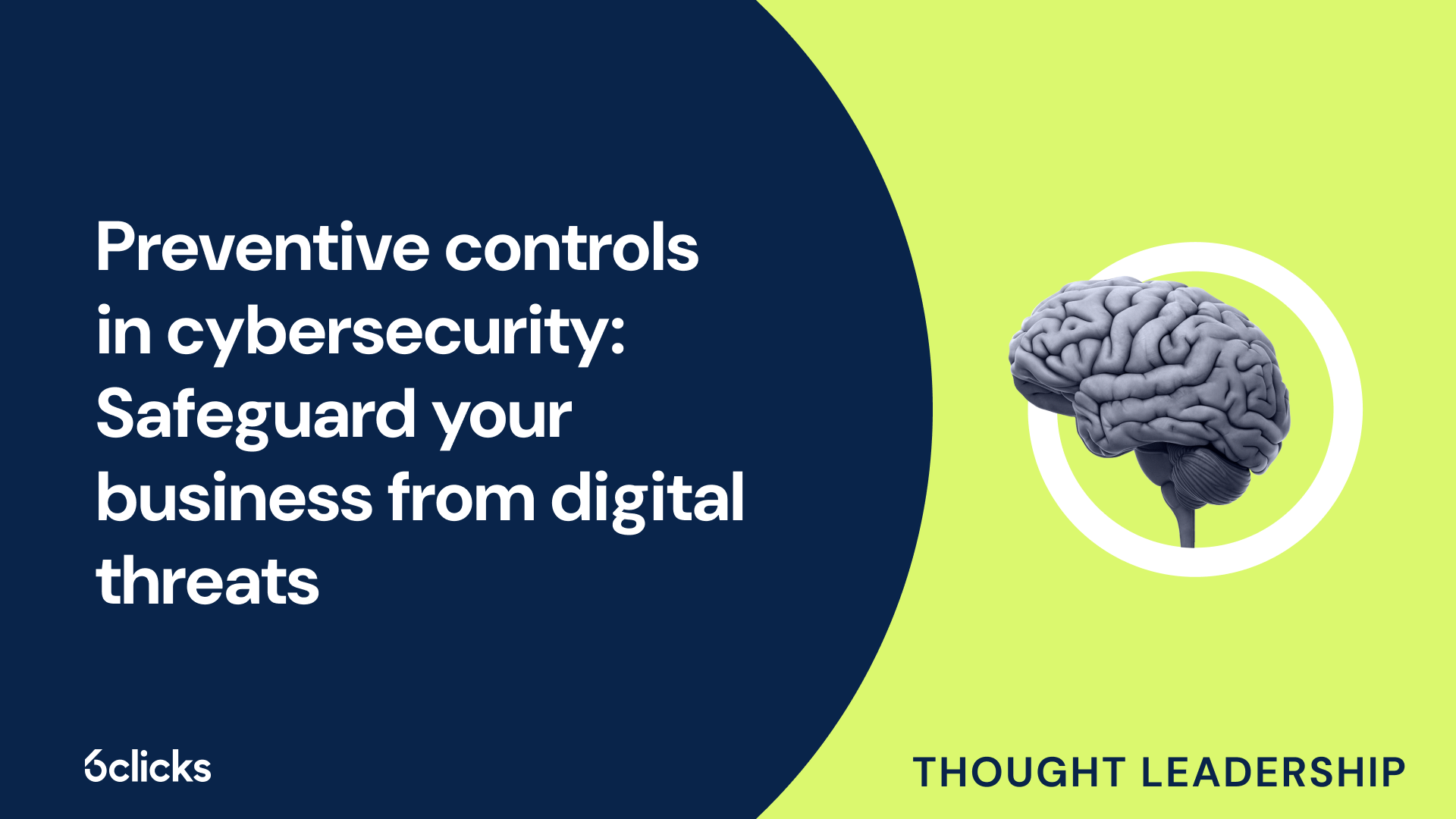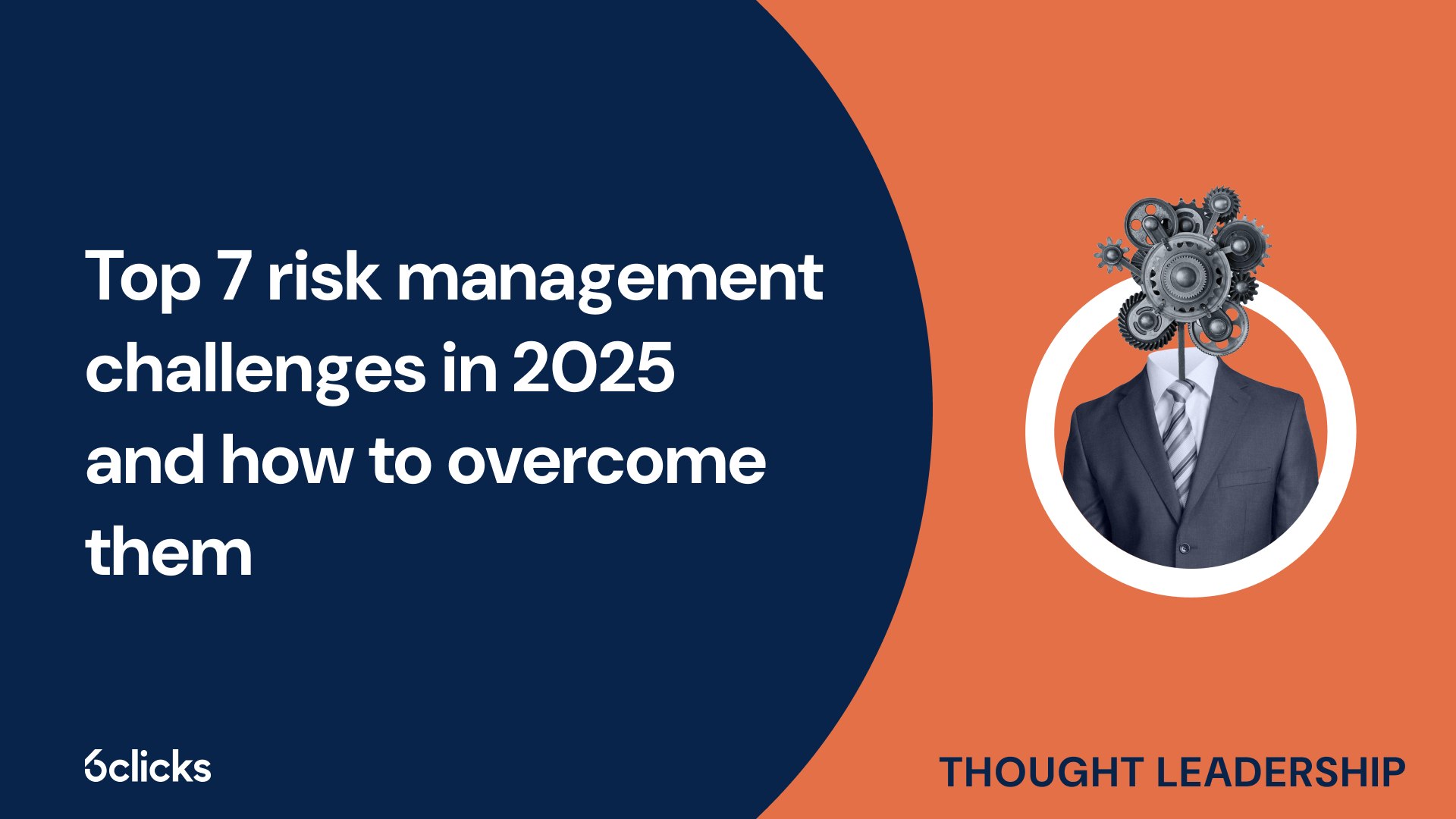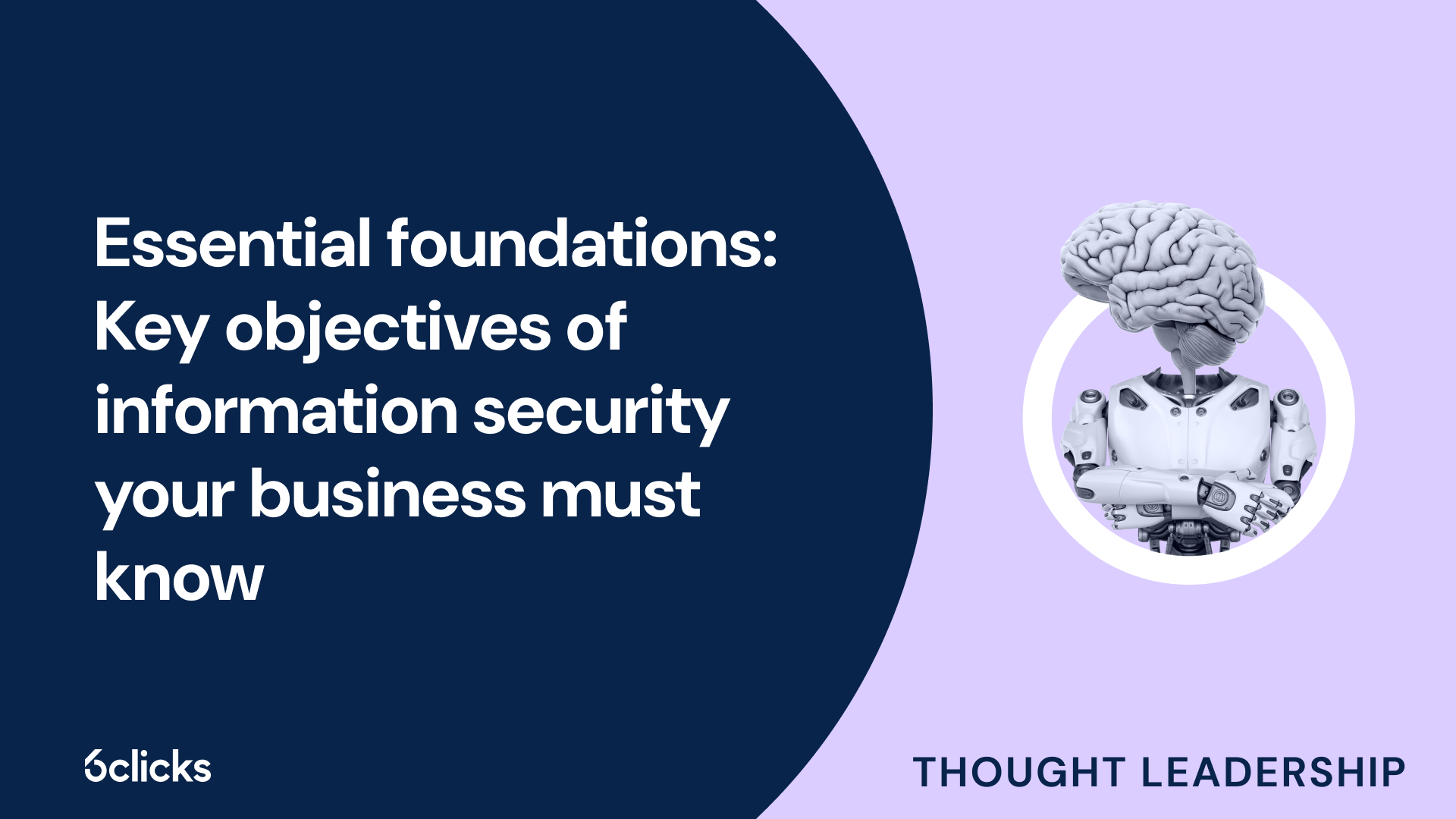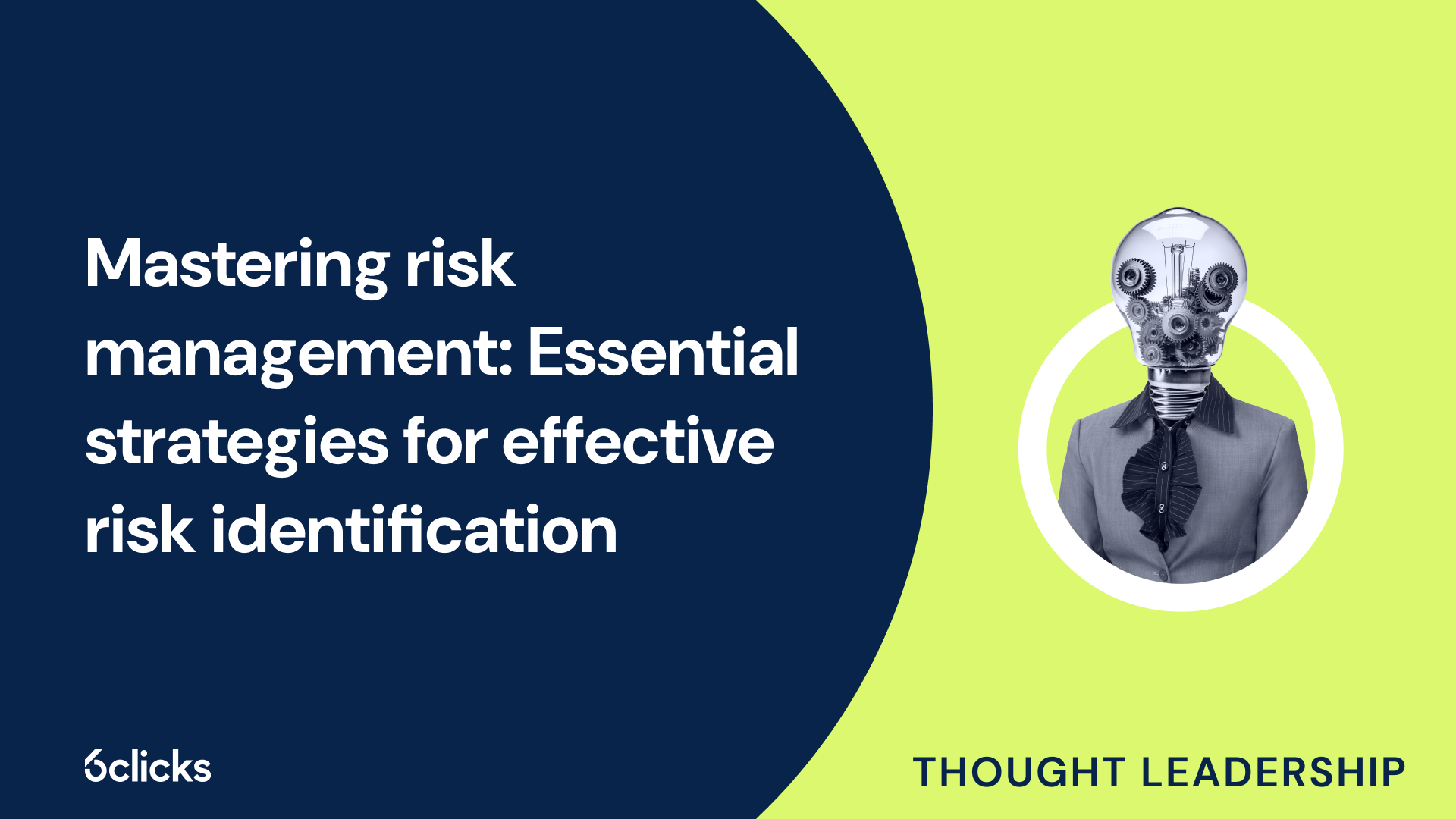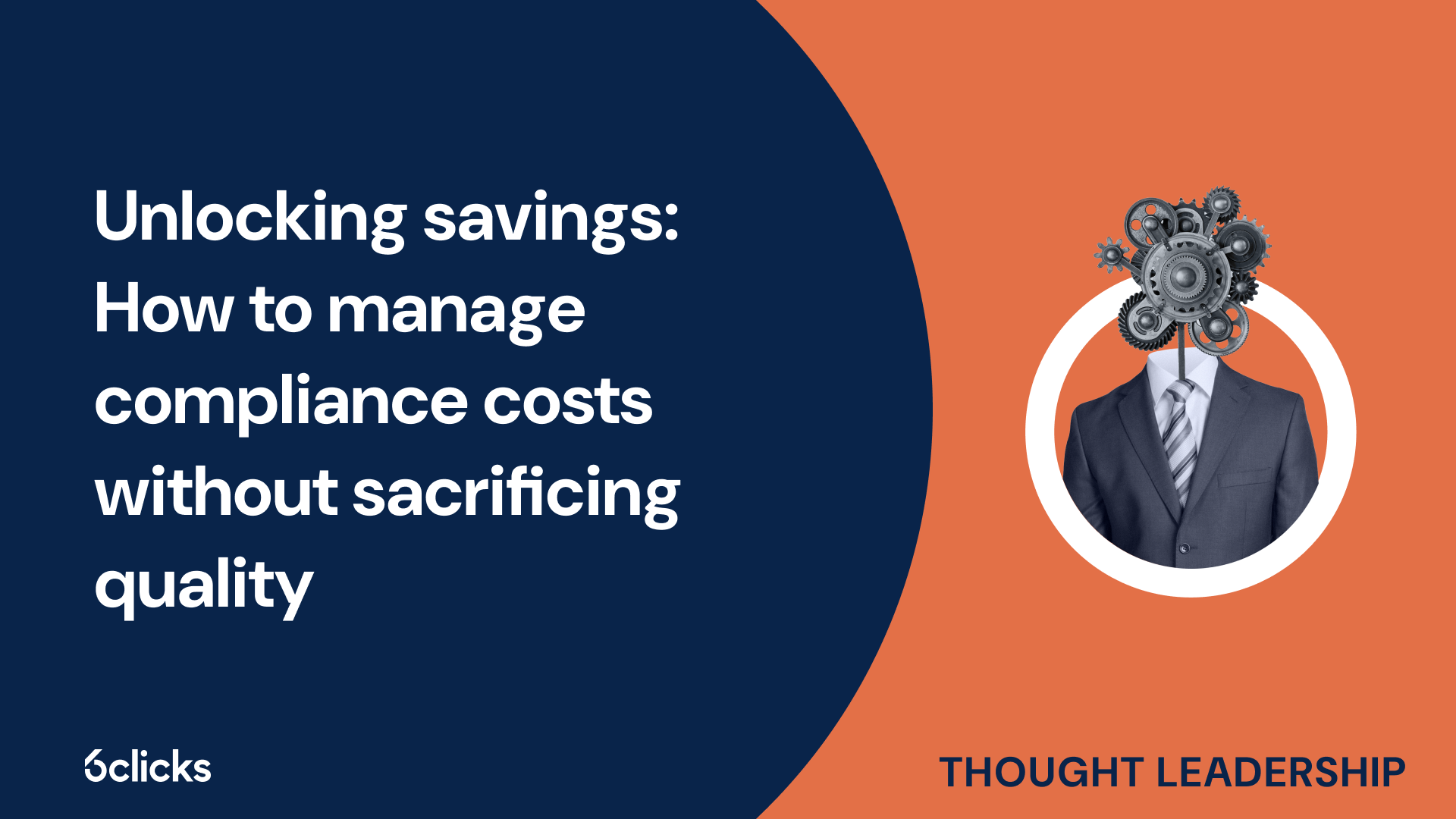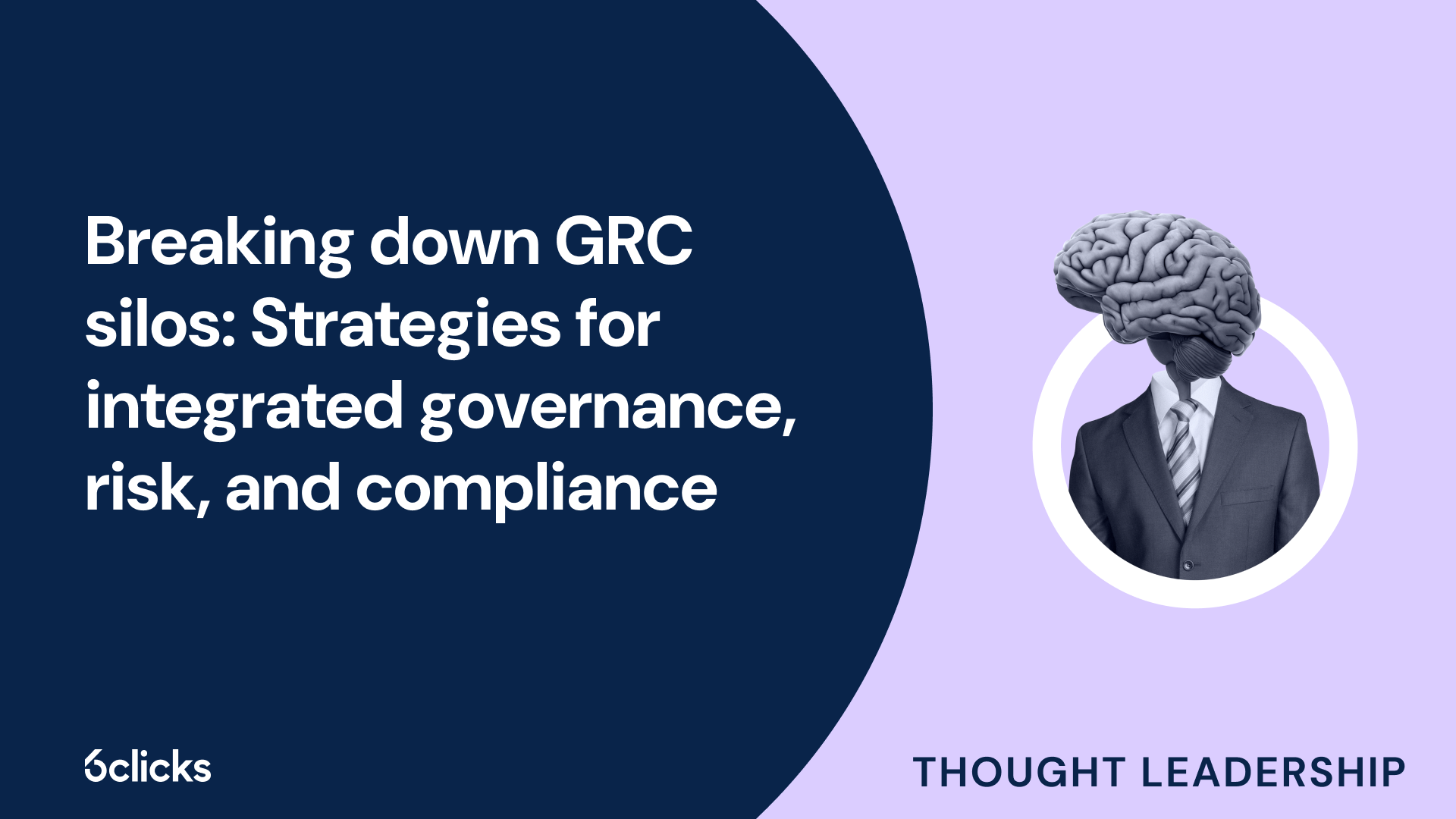The GRC buyer’s guide for 2025: Building resilience with AI-powered, federated solutions
Get the answer to this question "What iaDiscover the ultimate GRC buyer's guide for 2025! Uncover how AI-powered, federated solutions transform compliance and security management for industries like government, aerospace, banking, and more. Learn about centralized control, continuous compliance, and advanced cyber GRC capabilities. Download now!s SOC 2 compliance mean?" For risk and compliance leaders from the team at 6clicks
-1.png?width=200&height=249&name=Group%20193%20(1)-1.png)
The GRC buyer’s guide for 2025: Building resilience with AI-powered, federated solutions
What is SOC 2 compliance?
SOC 2 compliance refers to an auditing standard that assesses service organizations' operational policies and practices in relation to data security, privacy, processing integrity, confidentiality, and availability. SOC 2 compliance is based on the Trust Services Criteria, which are a set of principles developed by the American Institute of Certified Public Accountants (AICPA) to evaluate the effectiveness of a service organization's internal controls and processes. By obtaining SOC 2 compliance, service organizations can prove their commitment to security and demonstrate that they have implemented appropriate measures and controls to protect the data entrusted to them by their clients and business partners. SOC 2 compliance reports are conducted and issued by licensed CPA firms and provide valuable insights into the security practices and controls of service organizations, helping businesses make informed decisions about their choice of service providers.
Benefits of SOC 2 compliance
SOC 2 compliance has become increasingly important for organizations in today's digital landscape. By aligning with the Trust Services Criteria, SOC 2 compliance signifies an organization's commitment to information security, availability, processing integrity, confidentiality, and privacy.
One of the primary benefits of SOC 2 compliance is the potential to attract high-value clients and business partners. Many organizations require SOC 2 compliance from their service providers as a prerequisite for working together. By achieving SOC 2 compliance, your organization can open doors to new opportunities and partnerships.
Furthermore, SOC 2 compliance instills confidence and trust in your organization among your clients and stakeholders. It demonstrates your commitment to following best practices for information security and protecting sensitive data. This can be a deciding factor for clients in choosing to work with you, as they can have peace of mind knowing their information is in safe hands.
In addition to client and partner benefits, SOC 2 compliance also helps organizations meet market requirements. Many industries have specific compliance requirements, and SOC 2 can serve as an essential benchmark for meeting those standards. It ensures that your organization has the necessary security controls in place to safeguard against potential security incidents.
Trust services principles & criteria
Trust Services Principles (TSP) are a set of professional standards developed by the American Institute of Certified Public Accountants (AICPA). They provide a framework for evaluating the controls and procedures of service organizations related to security, availability, processing integrity, confidentiality, and privacy. The Trust Services Criteria (TSC) are specific control objectives and related controls that organizations must meet to demonstrate compliance with the TSP. These principles and criteria are the foundation of SOC 2 compliance, which is a widely recognized standard for assessing and reporting on the controls implemented by service organizations. Achieving SOC 2 compliance requires organizations to undergo an audit by a licensed CPA firm, who evaluates their controls against the TSC. This certification assures clients and stakeholders that the service organization has implemented the necessary measures to protect their data and meet the highest standards of security and privacy. It provides a reliable assurance that the organization can be trusted to handle sensitive information and mitigate risks effectively.
Security principle
The security principle is one of the five trust services principles that are the foundation of SOC 2 compliance. It focuses on preventing unauthorized use, access, and disclosure of assets and data. The purpose of this principle is to ensure that organizations have appropriate controls in place to protect the integrity, confidentiality, and availability of their systems.
To comply with the security principle, organizations should have robust access restrictions in place. This includes controls over logical and physical access to their systems, ensuring that only authorized individuals can access sensitive data or enter secure areas. Organizations should also have controls in place to monitor and track user activities to detect and deter unauthorized access attempts.
Change management is another critical aspect of the security principle. Organizations should have controls in place to manage and track changes to their systems, applications, and configurations. This helps to ensure that any changes made are authorized and do not introduce vulnerabilities or compromise security.
Risk mitigation is an essential part of the security principle. Organizations should conduct regular risk assessments to identify potential security threats and vulnerabilities. Based on these assessments, they should implement controls and measures to mitigate these risks and protect their systems and data.
Availability principle
In SOC 2 compliance, the availability principle focuses on ensuring that an organization's systems and components are accessible, maintained, and monitored to meet business objectives. This principle emphasizes the importance of having systems available and operational when needed, as well as minimizing any disruptions or downtime that may impact business operations.
To achieve compliance with the availability principle, organizations have certain obligations to fulfill. First, they must establish system accessibility controls, ensuring that authorized individuals can access the necessary resources and data. This involves implementing strong authentication mechanisms and access restrictions to prevent unauthorized access.
Maintenance is another crucial aspect of the availability principle. Organizations must regularly perform system maintenance activities to ensure the smooth functioning of their systems. This includes applying software patches, updating configurations, and conducting routine checks to identify and resolve any potential issues.
Monitoring is vital to proactively manage system availability. By implementing monitoring mechanisms, organizations can detect and respond to any performance or availability issues promptly. This involves tracking system usage, network bandwidth, and hardware performance, among other factors.
Additionally, organizations must have robust backup and disaster recovery plans in place to mitigate the impact of any unexpected events or disasters. Regularly testing these plans is essential to ensure their effectiveness and reliability.
By fulfilling these obligations, organizations can demonstrate their commitment to the availability principle and maintain the accessibility and reliability of their systems, ultimately enhancing their SOC 2 compliance posture.
Processing integrity principle
The processing integrity principle is a crucial component of SOC 2 compliance that focuses on ensuring consistent and accurate data processing. It revolves around the concept of maintaining a system that achieves its intended purpose while delivering reliable and valid information.
In the context of SOC 2 compliance, the processing integrity principle demands that organizations establish and maintain adequate security controls to protect data from unauthorized access, as well as to ensure the accuracy and integrity of data processing. These security controls include measures such as access restrictions, encryption, and monitoring systems to detect any potential threats or breaches.
The significance of security controls cannot be overstated when it comes to protecting data. Robust security controls act as a barricade against unauthorized individuals or entities, safeguarding sensitive information from external risks. They establish a secure foundation for consistent and accurate data processing, ultimately boosting confidence in the reliability of an organization's systems and operations.
To maintain processing integrity, organizations must also implement effective monitoring mechanisms, quality assurance practices, and timely issue resolution. These strategies help to identify and rectify any anomalies or errors that might arise during data processing, ensuring that information remains accurate and trustworthy.
By adhering to the processing integrity principle and implementing robust security controls, organizations can achieve SOC 2 compliance, demonstrating their commitment to processing data accurately, consistently, and securely.
Confidentiality principle
In SOC 2 compliance, the confidentiality principle focuses on protecting sensitive information from unauthorized access and ensuring its confidentiality. Meeting this principle entails implementing various obligations and requirements to safeguard confidential data.
One important aspect is identifying and categorizing sensitive information within the organization. This involves conducting a thorough assessment of the data being processed, stored, and transmitted. By classifying the data based on its sensitivity, organizations can determine the appropriate level of protection required.
To comply with the confidentiality principle, robust security measures must be in place. Encryption is a crucial method for protecting data both at rest and in transit. It involves converting the information into an unreadable format, making it unintelligible to unauthorized individuals.
Access controls also play a crucial role in confidentiality compliance. Organizations must establish stringent access restrictions to ensure that only authorized individuals can access sensitive data. This may involve implementing authentication mechanisms, like strong passwords and multi-factor authentication, along with role-based access controls to limit access privileges.
Additionally, organizations should maintain access logs to track and monitor all access attempts and activities related to confidential data. These logs serve as evidence in auditing and help detect and investigate any suspicious or unauthorized access.
Ultimately, organizations must implement a combination of technical and administrative controls to maintain the confidentiality of sensitive information. By adhering to the obligations and requirements set forth under the confidentiality principle, businesses can protect their data from unauthorized disclosure or access.
Privacy principle
The Privacy principle is a critical component of SOC 2 compliance, ensuring that a system conforms to privacy policies and the Generally Accepted Privacy Principles (GAPP). It focuses on protecting personal information collected, used, retained, and disclosed by an organization.
To comply with the Privacy principle, organizations must have clear and documented privacy policies in place. These policies outline how personal information is collected, used, retained, and disclosed, and provide details on individuals' rights in relation to their data.
SOC 2 compliance also requires organizations to implement techniques for securely collecting personal information. This includes obtaining consent from individuals before collecting their data, ensuring that data is only collected for specified purposes, and implementing measures to ensure the accuracy and security of the collected information.
Retention and disposal of personal information is another important aspect of privacy compliance. Organizations must establish policies and procedures for retaining and disposing of data in a secure manner, in adherence to relevant legal requirements and industry standards.
Furthermore, privacy notices play a crucial role in SOC 2 compliance. These notices provide individuals with clear and visible language about how their personal information will be collected, used, retained, and disclosed. It allows individuals to make informed choices about sharing their data and helps build trust between the organization and its customers or users.
By adhering to the Privacy principle, organizations can demonstrate their commitment to privacy protection and build trust with stakeholders, while also ensuring compliance with SOC 2 requirements.
Service organization controls (SOC) reports overview
Service Organization Controls (SOC) reports provide valuable information about the internal controls and security practices of service organizations. These reports are designed to help businesses and their business partners assess the effectiveness of a service organization's control environment, particularly in relation to privacy, security, and processing integrity. SOC reports are conducted by licensed CPA firms and are based on the Trust Services Principles and Criteria developed by the American Institute of Certified Public Accountants (AICPA). There are different types of SOC reports, including SOC 1, SOC 2, and SOC 3, each with specific focus areas and audiences. SOC 2 reports, in particular, focus on the controls and processes related to security, availability, processing integrity, confidentiality, and privacy. These reports are an essential tool for organizations to demonstrate their commitment to security and compliance, and to provide assurance to their clients and stakeholders.
Types of SOC reports
SOC reports, or Service Organization Control reports, are important tools used by service organizations to provide assurance to their customers and stakeholders regarding the effectiveness of their internal controls. There are several types of SOC reports, but two of the most common ones are SOC 2 Type I and SOC 2 Type II.
SOC 2 Type I reports are designed to evaluate the design and implementation of controls at a specific point in time. These reports assess a service organization's adherence to the Trust Services Criteria, which includes security, availability, processing integrity, confidentiality, and privacy.
On the other hand, SOC 2 Type II reports provide a more comprehensive evaluation of controls by assessing their effectiveness over a period of time, typically six to 12 months. This type of report provides a higher level of assurance as it demonstrates the service organization's ability to maintain and operate controls in accordance with the Trust Services Criteria throughout the assessment period.
Both SOC 2 Type I and Type II reports serve the purpose of providing customers and stakeholders with an understanding of the service organization's general IT controls and their commitment to security, confidentiality, and privacy. These reports are used to demonstrate the service organization's compliance with industry standards, regulatory requirements, and best practices. They are often requested by customers, business partners, and auditors as part of their risk assessment and vendor management processes.
Scope of a SOC report
The scope of a SOC (System and Organization Controls) report is an essential aspect to understand when evaluating a service organization's controls and compliance procedures.
In a SOC Type I report, the scope of the assessment encompasses the service organization's system(s) and evaluates the suitability of the design of controls at a specific point in time. This report provides valuable insights into the service organization's control environment and their commitment to security, privacy, and other trust service principles.
On the other hand, a SOC Type II report goes beyond the scope of a Type I report by also including descriptions of the operating effectiveness of controls over a period of time. This report provides a more comprehensive assessment by evaluating the service organization's ability to maintain and operate the controls in accordance with the Trust Services Criteria throughout the assessment period, typically six to 12 months.
The benefits of a SOC Type I report include gaining assurance about the service organization's control environment and the suitability of the design of their controls. It allows organizations and their business partners to assess the security posture and compliance of the service organization.
A SOC Type II report offers additional benefits by providing evidence of the operating effectiveness of controls over time, demonstrating the service organization's commitment to security, availability, processing integrity, confidentiality, and privacy. This helps organizations assess the long-term reliability and effectiveness of the controls.
When selecting the appropriate type of SOC report, organizations should consider their specific needs and the level of assurance required. If they need reassurance about the design of controls in a specific point in time, a SOC Type I report may be sufficient. However, if they require a more comprehensive evaluation of operating effectiveness over a period of time, a SOC Type II report is recommended.
Requirements for achieving and maintaining SOC 2 Compliance
Achieving and maintaining SOC 2 compliance requires service organizations to meet a set of rigorous requirements. These requirements are designed to ensure that the service organization has implemented effective internal controls to protect customer data and maintain the security, availability, processing integrity, confidentiality, and privacy of their systems. To achieve SOC 2 compliance, organizations must undergo a thorough risk assessment, implement appropriate security measures and controls, develop business processes and plans to mitigate risks, establish a strong control environment, and regularly assess and monitor their security practices. In addition, service organizations must engage a licensed CPA firm to conduct a compliance audit and provide an attestation report, which includes evidence of the organization's compliance with the trust services principles and criteria. Once SOC 2 compliance is achieved, organizations must maintain ongoing compliance through regular monitoring, assessment, and any necessary updates to their security controls and practices. By meeting these requirements, service organizations demonstrate their commitment to maintaining high standards of security and protecting the data and privacy of their customers.
Period of time covered by the report
When it comes to SOC 2 compliance, the period of time covered by the compliance report is an essential factor. The report typically covers a specific period, such as a fiscal year or a calendar year, during which the organization's controls and practices were assessed for compliance.
The period of time covered by the SOC 2 compliance report is important because it determines the validity and applicability of the report. This allows stakeholders to understand the time frame in which the assessment was conducted and the controls that were in place during that period.
For example, if a report covers the fiscal year 2020, it means that the assessment was conducted during that specific time frame and the report is applicable to the controls and practices in place during that year.
The period of time covered by the report is stated clearly in the compliance report, ensuring transparency and clarity for readers. This information helps organizations and their stakeholders understand the relevance and currency of the report's findings.
Internal control environment & security practices
To achieve SOC 2 compliance, organizations must establish a robust internal control environment and implement rigorous security practices. These measures are crucial for preventing unauthorized access and ensuring the security of sensitive data.
The internal control environment encompasses the policies, procedures, and processes put in place to manage and mitigate risks. It involves establishing a strong control framework that governs the organization's operations and protects its assets. This includes implementing controls over logical and physical access to systems and data, as well as defining and enforcing proper segregation of duties.
In terms of security practices, organizations must adopt comprehensive measures to safeguard data from unauthorized access. This includes implementing strong authentication mechanisms, such as multi-factor authentication, to control access to systems and data. Regular vulnerability assessments and penetration testing should also be conducted to identify and address potential security gaps.
Additionally, organizations must have robust change management processes in place to ensure that system changes are properly authorized, tested, and monitored. This includes implementing a formal change control procedure and conducting thorough impact assessments prior to implementing any changes.
Risk mitigation is another critical aspect of achieving SOC 2 compliance. Organizations must conduct regular risk assessments to identify potential threats and vulnerabilities, and then implement appropriate controls to mitigate these risks. This may involve implementing encryption mechanisms, firewalls, intrusion detection systems, and antivirus software.
Risks assessed during a SOC 2 audit
During a SOC 2 audit, several risks are assessed to ensure compliance with security, availability, processing integrity, confidentiality, and privacy principles. These risks include unauthorized access to systems and data, security incidents and breaches, service interruptions or disruptions, processing errors or omissions, data inaccuracies or inconsistencies, and unauthorized disclosure or theft of sensitive information.
Potential vulnerabilities and threats are evaluated to identify areas where controls should be implemented or strengthened. These can include weaknesses in logical and physical access controls, inadequate security measures, insufficient safeguards for data storage and transmission, insufficient monitoring and detection capabilities, inadequate disaster recovery and business continuity plans, and ineffective vendor management practices.
To address these vulnerabilities and threats, organizations must implement appropriate controls and security measures. These can include strong authentication mechanisms, encryption mechanisms, firewalls, intrusion detection systems, antivirus software, log monitoring and analysis, incident response plans, backup and restoration capabilities, and regular assessments and audits.
By assessing these risks, vulnerabilities, and threats during a SOC 2 audit, organizations can identify areas of improvement, strengthen their security posture, and demonstrate their commitment to security, availability, processing integrity, confidentiality, and privacy to their clients, business partners, and stakeholders.



